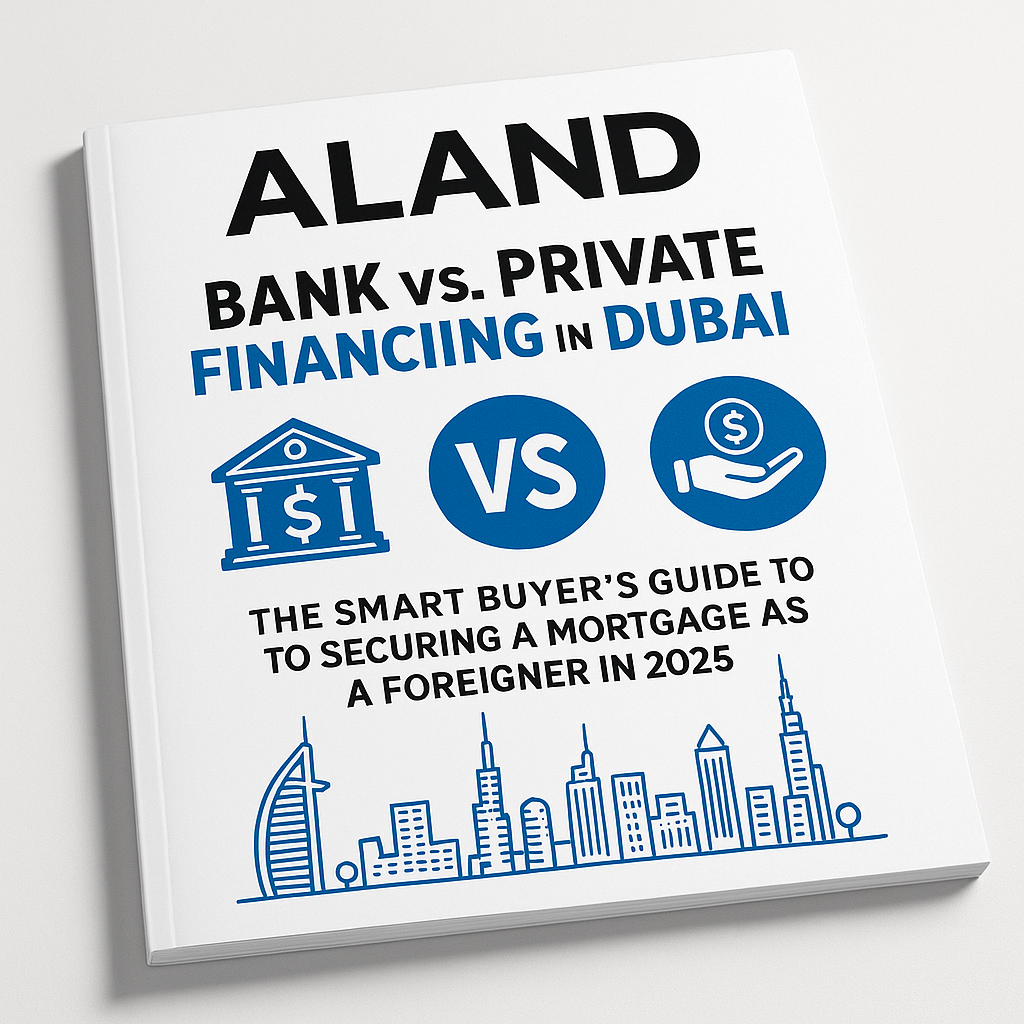Bank vs. Private Financing in Dubai: The Smart Buyer’s Guide to Securing a Mortgage as a Foreigner in 2025
- Published Date: 29th Sep, 2025
-
4.9★ ★ ★ ★ ★(133)

By Dr. Pooyan Ghamari – Swiss Economist, Founder of the ALand Platform
For many foreign investors, Dubai’s property market is the ultimate prize: tax-free rental income, long-term capital appreciation, and a Golden Visa gateway to one of the world’s most dynamic economies. Yet one major obstacle still keeps countless investors from stepping in — financing.
The question is simple but crucial: How do you fund a Dubai property purchase as a foreigner, and should you rely on traditional banks or private financing alternatives? The answer is far more nuanced than most guides admit. Each path has its strengths, costs, and strategic implications. And in 2025, with global liquidity tightening, interest rates stabilizing, and investor demand surging, the gap between the two approaches is wider — and more consequential — than ever.
This guide cuts through the fog. Whether you’re a first-time investor or a seasoned global buyer, understanding the real differences between bank and private financing could mean the difference between a strained purchase and a portfolio that compounds wealth year after year.
The Banking Route: Stability, Structure, and Scrutiny
For decades, bank mortgages were the default financing tool for property buyers in Dubai. And for good reason: they’re regulated, relatively predictable, and often cheaper than private alternatives — at least on paper.
Advantages:
-
Lower interest rates: 4.5%–6.5% for non-residents, slightly lower for residents
-
Long repayment terms, easing monthly cash flow
-
Regulatory security under UAE Central Bank oversight
-
Leverage preserves liquidity for other investments
Drawbacks:
-
Strict eligibility: higher documentation, income minimums (AED 15k–25k monthly), nationality-based risk assessments
-
Slow, bureaucratic approvals (weeks to months)
-
Conservative valuations and reluctance to finance off-plan
-
Limited flexibility in refinancing or adjusting terms
Bank financing is ideal for disciplined investors with stable income — but it’s not the only route.
Private Financing: Flexibility, Speed, and Strategic Leverage
Private financing — from developers, private lenders, international banks, or investment funds — is less standardized but increasingly important. It thrives where banks hesitate and serves investors who don’t fit neatly into traditional eligibility boxes.
Forms of private financing:
-
Developer payment plans: post-handover schedules, often interest-free
-
Private mortgage lenders: higher rates (7%–12%) but faster approvals
-
International mortgage brokers: bridge offshore capital to UAE deals
-
Corporate/SPV financing: portfolio-level loans with tailored terms
Advantages:
-
Residency not required
-
Flexible repayment schedules and balloon options
-
Approvals in days, not weeks
-
Works well for off-plan properties and unconventional deals
Drawbacks:
-
Higher borrowing costs (7%–12%)
-
Shorter terms (3–10 years)
-
Less regulatory oversight — due diligence essential
-
Some lenders require collateral beyond the property
Private financing is best for investors prioritizing speed, flexibility, and creative leverage.
Key Differences: Bank vs. Private Financing
| Factor | Bank Financing | Private Financing |
|---|---|---|
| Interest Rate | 4.5%–6.5% | 7%–12% (negotiable) |
| LTV | 80% (residents), 50%–75% (non-res.) | 60%–85%, varies |
| Repayment Term | 15–25 years | 3–10 years (longer with some developers) |
| Approval Time | 3–6 weeks | 3–10 days |
| Residency | Usually required (exceptions exist) | Rarely required |
| Documentation | Extensive | Moderate |
| Flexibility | Low | High |
| Off-Plan Access | Limited | Widely available |
| Regulation | Strong Central Bank oversight | Less regulated, requires due diligence |
Strategy Over Simplicity: Choosing the Right Path
-
Low cost & long-term stability → Bank financing
-
Speed, flexibility, no residency → Private financing
-
Capital growth over yield → Developer payment plans for leverage
-
Portfolio building → Hybrid strategy combining both
The Hidden Opportunities Few Investors Use
Sophisticated investors often blend both systems:
-
Bridge financing: Use private loans for speed, then refinance via banks
-
Portfolio leverage: Secure commercial-level loans through property-holding companies
-
Rental-backed repayment: Align developer payment schedules with rental flows
These hybrid approaches demand planning but unlock unmatched scalability.
The ALand Advantage
Platforms like ALand simplify this complexity by integrating:
-
Comparative analysis of bank vs. private terms
-
Negotiation to reduce hidden fees
-
Structuring for Golden Visa eligibility
-
Risk management and FX strategy
With the right advisory, financing becomes more than an obstacle — it becomes a wealth multiplier.
Final Thought
In Dubai’s property market, financing is not just a transaction — it’s a strategy. Bank loans bring stability and low costs, while private financing offers agility and unconventional access. The smartest investors in 2025 aren’t choosing one or the other. They’re mastering both — deploying each where it delivers the greatest advantage.
Dr. Pooyan Ghamari is a Swiss Economist, visionary strategist, and founder of the ALand Platform – a global hub for real estate intelligence, economic strategy, and cross-border investment solutions.

